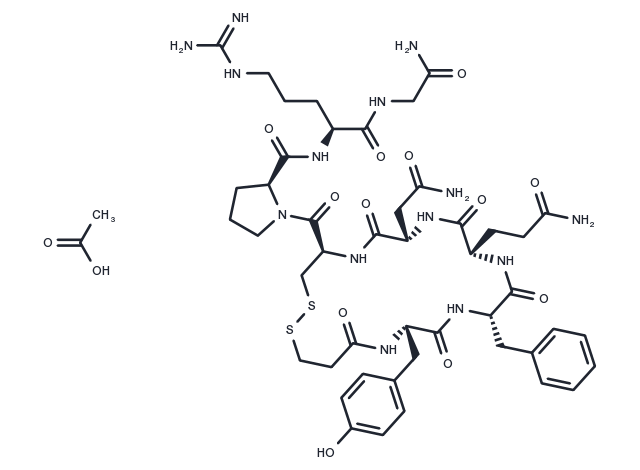store at low temperature,keep away from moisture
Powder: -20°C for 3 years | In solvent: -80°C for 1 year

Desmopressin acetate (16679-58-6 free base) (DDAVP) is the synthetic analog of the antidiuretic hormone arginine vasopressin. Vasopressin Receptor The antidiuretic properties of desmopressin have led to its use in polyuric conditions including primary nocturnal enuresis, nocturia, and diabetes insipidus. Desmopressin acetate (16679-58-6 free base) works by limiting the amount of water that is eliminated in the urine. Desmopressin acetate (16679-58-6 free base) binds to V2 receptors in renal collecting ducts, increasing water reabsorption. It also stimulates the release of von Willebrand factor from endothelial cells by acting on the V2 receptor.

| Pack Size | Availability | Price/USD | Quantity |
|---|---|---|---|
| 1 mg | In stock | $ 45.00 | |
| 2 mg | In stock | $ 62.00 | |
| 5 mg | In stock | $ 98.00 | |
| 10 mg | In stock | $ 148.00 | |
| 25 mg | In stock | $ 252.00 | |
| 50 mg | In stock | $ 379.00 | |
| 100 mg | In stock | $ 567.00 |



| Description | Desmopressin acetate (16679-58-6 free base) (DDAVP) is the synthetic analog of the antidiuretic hormone arginine vasopressin. Vasopressin Receptor The antidiuretic properties of desmopressin have led to its use in polyuric conditions including primary nocturnal enuresis, nocturia, and diabetes insipidus. Desmopressin acetate (16679-58-6 free base) works by limiting the amount of water that is eliminated in the urine. Desmopressin acetate (16679-58-6 free base) binds to V2 receptors in renal collecting ducts, increasing water reabsorption. It also stimulates the release of von Willebrand factor from endothelial cells by acting on the V2 receptor. |
| Synonyms | Desmopressin acetate, DDAVP |
| Molecular Weight | 1129.26 |
| Formula | C48H68N14O14S2 |
| CAS No. | 62288-83-9 |
store at low temperature,keep away from moisture
Powder: -20°C for 3 years | In solvent: -80°C for 1 year
H2O: 50 mg/mL
DMSO: 10 mM
Ethanol: Soluble
You can also refer to dose conversion for different animals. More
bottom
Please see Inhibitor Handling Instructions for more frequently ask questions. Topics include: how to prepare stock solutions, how to store products, and cautions on cell-based assays & animal experiments, etc.
Desmopressin acetate (16679-58-6 free base) 62288-83-9 GPCR/G Protein Vasopressin Receptor Desmopressin acetate (16679 58 6 free base) Desmopressin acetate 16679-58-6 Desmopressin Acetate 16679-58-6 free base DDAVP Desmopressin acetate (16679586 free base) inhibitor inhibit
